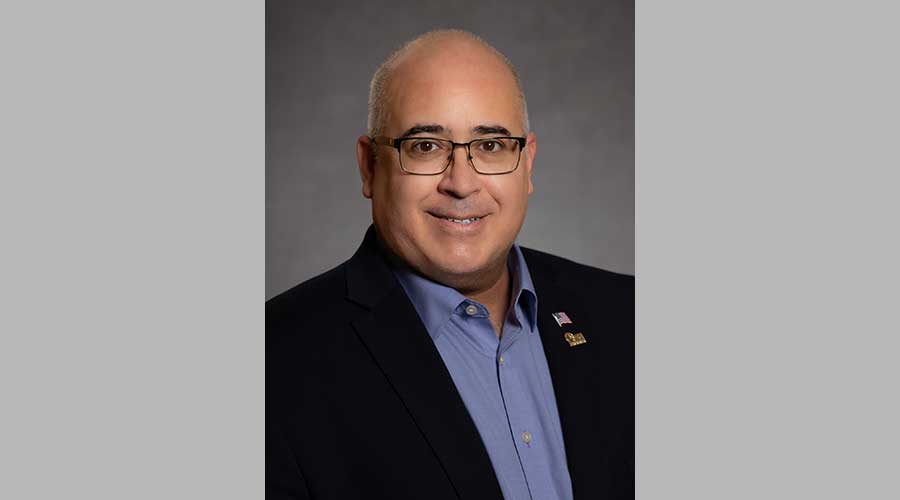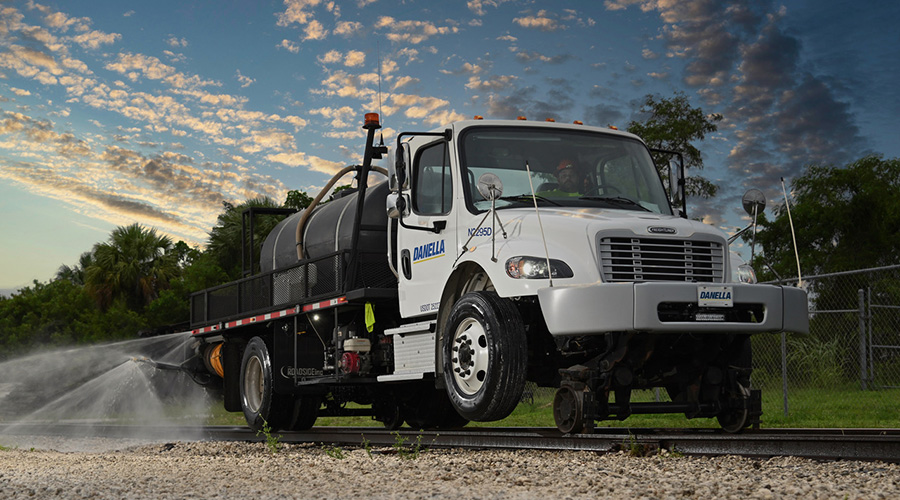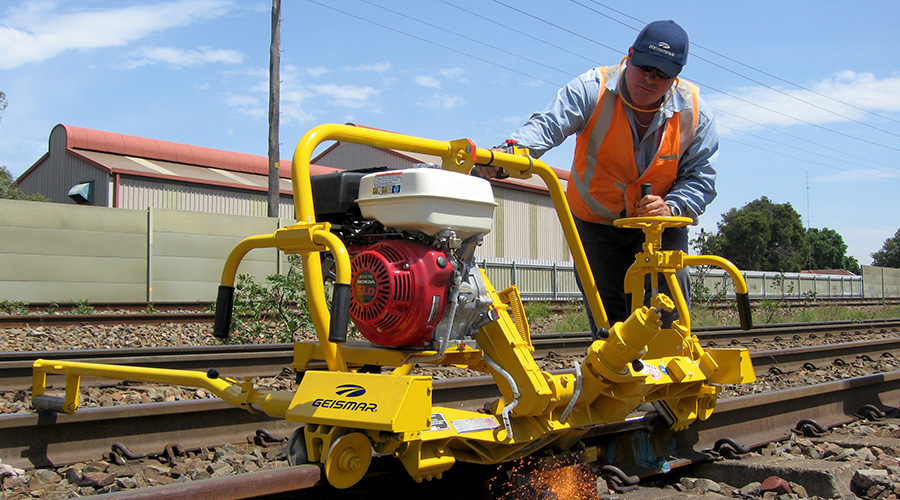Stay updated on news, articles and information for the rail industry
October 2012
Rail News: MOW
Suppliers of railroad ties dedicate more resources to fulfill railroads' crosstie needs
— compiled by Walter Weart
If Railway Tie Association (RTA) officials were to sum up the current state of the railroad tie market in one word, it probably would be "healthy." Through July, wood-tie production was up a robust 17.2 percent to 14.8 million units and purchases were up a solid 21 percent to 15 million units compared with figures from 2011's first seven months, according to RTA statistics.
The primary reason for the general health? Many railroads have determined that consistent and stable investments in maintenance-of-way (MOW) materials, especially ties, provide long-term cost stability and lifecycle performance benefits that can be realized in coming years, said RTA Executive Director Jim Gauntt in an email.
Another factor impacting railroads' investments and, in turn, tie demand: the amount of infrastructure being built to support crude-oil and gas extraction from shales, said Gauntt. Growing movements of frac sand, pipe and other materials have had a positive impact on tie demand from Class Is and other tie purchasers, he added.
By year's end, purchases of wood ties — which account for the vast majority of the tie market — are projected to total 22.17 million units, which would represent a 1.3 percent increase from 2011's level, according to RTA estimates.
Class I purchases are forecasted to total 17.67 million units and small-market purchases are projected to total 4.5 million units versus 16.52 million and 5.3 million, respectively, in 2011.
The wood-tie market figures to keep going strong the next three years, according to RTA projections. Purchases are forecasted to rise 0.9 percent in 2013 to 22.38 million units; 2.2 percent in 2014 to 22.87 million units; and 4.2 percent in 2015 to 23.83 million units.
Class I purchases are projected to total 17.9 million in 2013, 18.7 million in 2014 and 19.3 million in 2015.
While strong demand is expected to last a few more years, new preservative techniques are helping wood ties last several more years in the field. There are multiple ways of applying borates with creosote to extend tie life, said Gauntt.
In addition, two new primary preservatives — copper naphthenate and ammoniacal copper zinc arsenate (ACZA) — now have been standardized by the American Wood Protection Association for use with hardwood and/or softwood ties, he said.
The preservatives can be used with boron-based dual-treatment methodologies. Copper naphthenate treatments are designed to prevent mildew, mold and dry rot, as well as preserve wood against a broad spectrum of fungi, termites and other wood-destroying insects.
Decisions, Decisions
Railroads now have nearly 20 wood preservation choices to select from, which is "quite a change from five to 10 years ago," said Gauntt.
And a number of railroads are making those choices. Norfolk Southern Railway is installing sizable quantities of copper naphthenate-treated ties this year, according to the January/February 2012 issue of RTA's Crossties magazine.
Other railroads are using ACZA-treated ties, particularly on the West Coast with Douglas fir ties, said Gauntt.
According to a report issued by Harsco Rail's ZETA-TECH last year, wood-tie life can be extended via dual treatment with creosote and borate.
In the United States, average tie life can increase from 35.2 years to 40.4 years, the report states.
Wood-tie suppliers are noting railroads' growing interest in dual-treated ties. Koppers Inc. is allocating more resources to meet increasing demand for dual-treated borate ties.
In January, the company began treating ties with borate at its Galesburg, Ill., plant, bringing the number of plants offering the treatment service to four. Koppers also performs the treating service at facilities in Florence, S.C., Green Spring, W.Va., and Somerville Texas.
"The demand for dual-treated ties from several Class Is has increased dramatically over the past three years," said Tom Niederberger, Koppers' vice president of marketing and sales, in an email. "Research has shown that the use of borate-treated ties extends tie life in high-decay zones."
Koppers' business has been very solid so far in 2012 and figures to remain "pretty vibrant" for the balance of the year, he said. Class I demand has remained relatively consistent over the past several years, but the short line/contractor market registered a recent spike even though the Section 45G short-line tax credit — which has a proven record of stimulating tie demand — so far has not been extended for 2012, said Niederberger.
This year also has been a good one so far for Stella-Jones Inc., which in late 2011 acquired wood-tie supplier Thompson Industries Inc. Through the year's first three quarters, production was at or near record volumes with all of the company's customer groups, said Stella-Jones Vice President of Marketing George Caric in an email.
"This year's high tie volumes are being driven by a continued commitment by Class Is to invest in their maintenance programs, as well as a strong regional and short-line market due in large part to the short-line tax credits," he said. "We have also noticed a slight increase in the industrial market, where we see new and existing companies invest in rail infrastructure as a result of the rebounding economy."
CN Line A Signature Project
Class I demand remains strong because the large railroads have many new construction projects in the works, said Caric.
Stella-Jones has had several signature projects this year, including one with CN to totally rehabilitate a line in Baron Country, Wis., to provide rail service to a frac sand supplier, he said.
Stella-Jones now is offering a single-step boron, creosote treatment at its Russellville, Ark., plant to supply BNSF Railway Co. and Union Pacific Railroad with dual-treated ties.
In addition, transit inquiries for 2013 remain strong and should be in line with what the company registered for 2012, said Caric. He believes the future of transit business will rely on available funds and the support that agencies receive from state and federal levels.
"We are expecting the strong demand for crossties to continue through 2012 and [potentially] level off in 2013 as a result of the uncertainty of the outcome of the presidential election this year," said Caric. "We all need to keep the pressure on the House and Senate to support the railroad industry and its suppliers."
A continuation of burgeoning demand means Boatright Cos.' crosstie division, Boatright Railroad Products, expects to remain busy into next year.
Fuel prices and increased railroad efficiencies should continue to drive the growth in demand that's been witnessed the past several years, said Boatright Cos. Chief Executive Officer Shane Boatright in an email.
"Infrastructure will continue to be maintained at current levels along with the possibility of new construction of a second track to alleviate congestion and increase track time," he said.
Coming Soon: New Alabama Plant
Boatright Railroad Products has ramped up inventory and production at its existing facility in Montevallo, Ala., in anticipation of a new plant coming online in Lomax, Ala., in January 2013, said Boatright. The new facility will treat 2 million dry ties annually and has room for future expansion, if needed, he said.
"This plant will also produce both bridge and switch ties, providing 100 new jobs as well as adding 750,000 ties to [the division's] existing capacity," said Boatright.
Boatright Railroad Products is offering creosote and copper napthenate as an encapsulate for borates, and has made investments this year to achieve the most state-of-the-art and efficient borate-treating operation, he said.
The company is the first to offer both creosote and copper napthenate/borate pre-treated ties from a single facility, said Boatright.
Boatright Railroad Products is working closely with CSX Transportation and NS to supply copper napthenate/borate-treated ties.
"Class Is will continue to pursue alternative preservatives to increase tie life and maintain environmental integrity," said Boatright.
Tie Sales Times Four
Class Is are part of the reason business also is booming for National Salvage & Service Corp., which provides oak and hardwood borate/creosote dual-treated ties, creosote- and copper napthenate-treated ties, switch and crossing ties, and bridge approach and bridge ties and timbers.
New-tie sales have quadrupled so far this year, said VP of Sales, Marketing and Business Development Jeff Broadfoot, adding that the company's treating plants are working 24/7 to keep up with demand.
Railroads continue to accelerate their orders from last year, especially for borate/creosote dual-treated ties, which are installed in tracks located in higher-decay areas of the United States, Mexico and South America, he said.
More copper napthenate-treated ties are being specified and installed by railroads, such as NS and CSX, which recently approved the usage of those ties, he said.
In the meantime, other railroads are evaluating copper napthenate-treated ties as an alternative to standard creosote-treated ties, said Broadfoot.
National Salvage also is working with research and development consulting firm TASKpro to develop supplemental treatments for in-track and recycled ties for use in lower-tonnage tracks. TASKpro has used liquids, gels, pastes and solid rods to add supplemental treatments to ties, said Broadfoot.
"Over the years, TASKpro has utilized mainly borate-based products in their research and small-scale treatments, but they have also evaluated … fluorides and copper-based products," he said.
At Gross & Janes Co., annual borate treating capacity recently was increased by 500,000 units at a new Taylor, Ark., facility.
In early 2012, the company acquired a tie production plant in Taylor and 4,200 acres of hardwood timber in Arkansas and Louisiana from Tucker Lumber Co. and Smith-Turner Land Co. The Taylor plant was expected to process 400,000 ties annually, with a large portion of them to be pre-treated with borate.
Gross & Janes' business has been steady, with full-year projections suggesting a single-digit percentage increase over 2011, said President and CEO Michael Pourney in an email.
And from all indications, Class I demand will remain fairly strong during the next couple of years, he added.
Brisk Business
Appalachian Timber Services L.L.C. also is registering brisk business this year, said VP of Sales and Marketing Rick Gibson in an email, adding that sales are at least keeping pace with 2011.
The company has received orders from MTA New York City Transit (NYCT) and Amtrak this year.
In the short term, business will remain steady through the fourth quarter, said Gibson.
But in the long term, a slowing trend with industrial customers, especially coal mines, could impact sales, he believes. Regulations and coal surpluses have slowed and, in some cases, stopped production, causing mining companies to delay and even cancel orders, he said.
Business is encouraging so far this year in the concrete-tie market, as well. CXT Inc., a wholly owned L.B. Foster Co. subsidiary, has garnered orders in both the transit- and freight-rail sectors.
The transit orders include one from Sonoma-Marin Area Rail Transit (SMART) for 89,175 concrete ties. CXT's ties with Fastclips will be installed on the new San Francisco Bay Area passenger-rail system connecting Sonoma County to the Larkspur Ferry Terminal in Marin, Calif.
L.B. Foster began shipping ties to the general contractor, Stacy and Witbeck Inc./Herzog Contracting Corp. Joint Venture, in June and expects to complete delivery in second-quarter 2013.
SMART specified CXT concrete ties over wood ties for the project after researching both products' environmental and cost benefits, said Mark Hammons, CXT's national sales manager, in an email.
A SMART project design report noted that the use of concrete ties would reduce track costs 10 percent to 15 percent compared with installing timber ties using conventional track construction methods, he said.
In addition, the Tri-County Metropolitan Transportation District of Oregon ordered 21,000 concrete ties for the Portland-Milwaukie extension, a new 7.3-mile light-rail alignment that's scheduled to begin operation in 2015. CXT also received an order from Foothill Transit Constructors, a Kiewit Parsons joint venture, for 66,000 concrete ties to be installed for southern California's Metro Gold Line Foothill Extension.
On the freight side, CN has purchased 64,000 of CXT's concrete ties for track and siding projects, and UP has ordered more than 500,000 units, a large majority of which will be supplied for the Illinois high-speed rail route, said Hammons.
Chip Off The Old Block
CXT, which operates production plants in Spokane, Wash., and Tucson, Ariz., has entered the remote monitoring market by embedding a Radio Frequency Identification-integrated circuit chip in its tie.
The chip contains a bar-coded serial number that can be "read" by a person if the overlay is chipped away, said Hammons.
Remote monitoring benefits railroads because all associated component attributes are easily retrievable in real time and positioned on an interactive Google-style map, enabling the efficient application of product lifecycle management principles, he said.
At KSA, Koppers' concrete-tie division, efforts currently are focused on building a Low Vibration Track (LVT) for NYCT.
An ongoing project, the LVT comprises reinforced concrete block, a resilient pad and a rubber boot surrounded by unreinforced concrete, said KSA General Manager Scott Craig.
LVT's advantages include more efficient vibration protection, high flexibility, low installation and maintenance costs, no electrical conductance and flexible drainage system design, he said.
Overall, KSA's business has been "the best we've seen in recent years," said Craig, adding that the company is working with CSXT on a project in Florida and participating in a freight-rail project in East St. Louis.
For Rocla Concrete Tie Inc., production volumes continue to show signs of strengthening from year to year, said Sales Manager Brett Urquhart in an email.
The western Class Is continue to use concrete ties in steady quantities, and Rocla's partnerships with both UP and BNSF will keep the supplier's Denver and Amarillo, Texas, plants busy through year's end, he said. The company also operates a plant in Bear, Del.
Tied To Transit
The transit market is strong, as well, with Dallas Area Rapid Transit's expansion and the Regional Transportation District (RTD) of Denver's FasTracks program continuing to be a focus for tie contracts, said Urquhart.
Rocla expects to complete production of concrete ties for RTD's Eagle P3 commuter-rail project by 2012's end.
As a result of the FasTracks program, Rocla agreed to vacate its Denver plant, which will become the site of a RTD maintenance shop.
Rocla is building a new facility in Pueblo, Colo., that will feature 50 percent more capacity than the Denver plant, Urqhart said. Slated to open in December, the plant will provide increased efficiency to meet current and future requirements of the western Class Is, as well as other transit/industrial projects, he said.
The new plant, combined with existing operations, will enable Rocla to produce more than 1 million ties per year, he said.
Business continues to brew in the plastic/composite tie sector, too. Axion International Holdings Inc., which supplies an ECOTRAX® composite tie produced from 100 percent recycled materials, has been working with a Class I since January, said Axion CEO Steve Silverman.
In addition, Trinity Railway Express installed 3,000 Axion ties on a 2.5-mile section of Dallas/Fort Worth-area track, including the BeltLine Overpass, in November 2011. And in March, the company obtained a second order from Bay Area Rapid Transit for switch ties.
On the international front, Axion this year landed tie orders from New Zealand's Kiwi Rail, as well as from one of Brazil's largest railroads and one of the world's largest mining companies.
Mining industry applications subject the composite ties to "severe service," said Silverman.
At Your Service
Axion's ties have been tested in nearly every continent and found to work very well under all conditions, he said.
The firm's ties have been in service on MTA Long Island Rail Road for 10 years, and when four ties were removed in December and tested in March, "they were still in excellent condition," said Axion Sales Manager Cory Burdick.
The condition of the overall tie market is so favorable — despite a still-weak economy and absence of a short-line tax credit extension — that 2012 could be an historic year in the making, according to a prediction issued by the RTA in the first quarter.
Market stakeholders won't have to wait too much longer to find out if that prognostication holds true.
Walter Weart is a Denver-based free-lance writer.


 2025 MOW Spending Report: Passenger-rail programs
2025 MOW Spending Report: Passenger-rail programs
 Gardner steps down as Amtrak CEO
Gardner steps down as Amtrak CEO
 Guest comment: Oliver Wyman’s David Hunt
Guest comment: Oliver Wyman’s David Hunt
 Women of Influence in Rail eBook
Women of Influence in Rail eBook
 railPrime
railPrime






